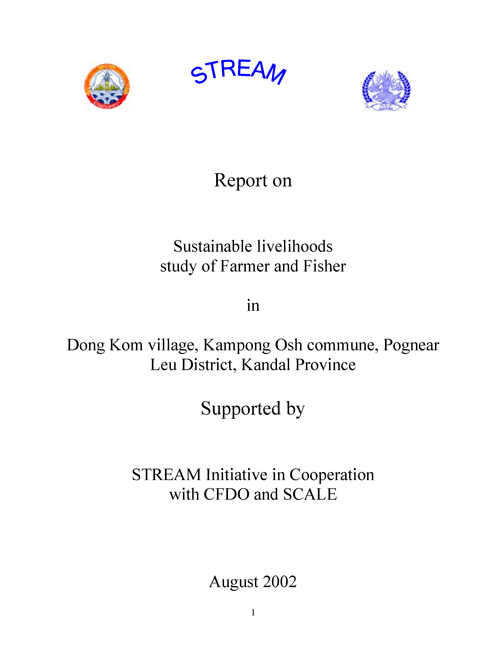Report on sustainable livelihoods study of farmers and fishers in Dong Kom Village, Kandal Province, Cambodia
1 August 2002 | 1382 Downloads | .pdf | 559.78 KB | Cambodia, Gender, Livelihoods, gender and social issues
The main objectives of this study, which is based on the current population census (1998) and key informant interviews (10 to 50 villagers voluntarily represented the 253 families of Dong Kom Village, Kampong Osh Commune, Pognear Leu District, Kandal Province) is to build capacity of CFDO and provincial staff to conduct sustainable livelihood (SL) study using a more participatory approach. The SL study team, comprised of 1 from CFDO, 4 and 2 from Kandal Provincial Fisheries office and Kandal Department of Women's Affairs respectively.
Before conducting the field study, they were trained for three days in how to use various PRA tools and techniques. They spent five days in the village to investigate the people’s livelihood and resources available in the village.
There were 253 families with a total population of 1,192 persons (611 female and 581 male) of which they were classified as follows: 17% - very poor, 29% - poor, 35% - fair, 15% - fairly rich and 4% - rich family. The primary occupation of villagers was farming, growing dry season rice on 1900 ha, besides that they grow other vegetable such as corn, pumpkin, chilies, wax gourd and other vegetables on 200 ha. The secondary occupation was fisher, teacher, traditional medical practitioner, doctor, barbers and other services.
The majority of fairly rich and rich families have agricultural machineries such as tractors, plowing machines, threshing machines and milling machines and have more land while the poor and fair have to hire those agricultural machineries and have less land.
The main infrastructure and resources available in the village were two lines of rural road, one primary school, 19 reservoirs, 2 big lakes, one river, three canals and 450 ha of flood forest.
Traditionally people help each other, especially in the special occasions such as weddings, village ceremonies and they exchange labor during dry rice season. In addition they formed a community fishery, a water usage committee and they charitably contribute to restore the village road and dam.
However there was a growing concern with the increasing population, destruction of flood forest, reduction of soil quality due to the increased use of inorganic fertiliser. In addition this village floods every year, which seriously effects village infrastructure and agriculture produce. Lack of communication with outsiders restrains them from access to a health care center, getting a good price for their agricultural produce and to getting low interest rates, as result more and more villagers are getting poorer.
The villagers request assistance from related institutions to provide them food for labor so that they can use the labor to restore the reservoir, credit for buying inorganic fertiliser and other needs as required improving their livelihood.
There were some issues threatening their livelihood such as some reservoirs already lost their structure and need to be restored, community fishery’s by-law were not fully followed which in turn meant some villagers were not satisfied. Conservation of flooded forest has impaired some people from expanding their dry season rice field and cutting for wood. The number of very poor people will increase unless there is intervention from other related institutions since most of the means of production belongs to the rich so the poor need to hire. Traditional use of organic fertiliser was disappearing as the number of animals has declined, subsequently people turn to use inorganic fertiliser instead which is believed to reduce soil quality.
This publication is also available in Khmer.
Creative Commons Attribution.

